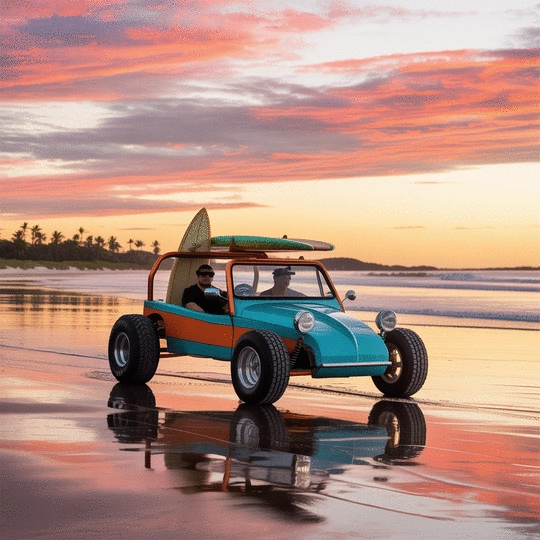Engine Tips for Beach Buggy Racing
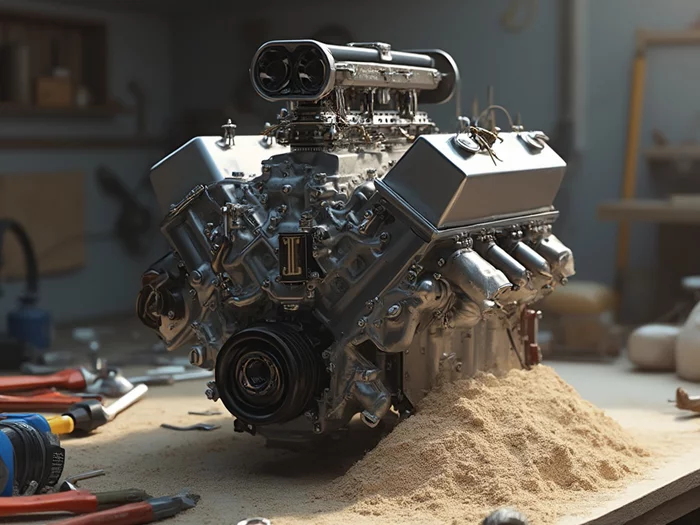
Posted on: 2025-10-12
By: Jasper Quinn
Have you ever felt the rush of navigating through soft sand with a powerful beach buggy? The right engine design is key to transforming that dream into an exhilarating reality. In this guide, we’ll explore the essential components that set beach buggy engines apart and help you achieve unparalleled performance on sandy terrains.
What You Will Learn
- Power-to-weight Ratio: A lighter engine enhances acceleration, crucial for sand racing success.
- Air-Cooled Design: Minimizes overheating risks, especially in hot climates.
- Engine Type Selection: The choice between VW air-cooled or motorcycle engines impacts overall performance.
- Optimal Horsepower: Aim for at least 100 horsepower for effective sand performance.
- Carburetor Tuning: Proper tuning maximizes fuel efficiency and output, crucial for variable terrains.
- Community Engagement: Connecting with fellow enthusiasts enriches your building experience and provides valuable insights.
Optimizing Beach Buggy Engine Performance: Key Focus Areas
Understanding the critical elements of beach buggy engine design for sand racing can significantly enhance performance. The visual below highlights the primary components and characteristics that contribute to a high-performance engine.
Engine Design Priorities
- ✓Power-to-weight ratio
- ✓Air-cooled design
- ✓Strength & durability
Ensuring agility and resilience in sandy conditions.
Performance Components
- ★Engine Type (VW air-cooled, motorcycle)
- ★Horsepower (min. 100 HP recommended)
- ★High Torque for acceleration
- ★Camshaft & intake upgrades
Balancing power and handling for ultimate sand racing.
Fuel System Optimization
- ▶Well-tuned carburetor
- ▶High-flow fuel systems
- ▶Optimal air/fuel mixture adjustments
Crucial for efficient running in varying terrains.
Fine-Tuning & Testing
- ⚙Dyno testing for HP & torque
- ⚙Monitor air/fuel ratios
- ⚙Real-world test runs on sand
- ⚙Document findings for improvements
Continuous enhancement for peak performance.
Understanding the Essentials of Beach Buggy Engine Design for Sand Racing
When it comes to sand racing, having a robust engine is crucial! Beach buggy engines are specifically designed to tackle sandy terrains, providing the power and agility needed to navigate through challenging conditions. Unlike standard vehicle engines, beach buggy engines have unique characteristics that make them ideal for performance in soft sand. Let's explore what makes these engines special and the key components that lead to successful sand racing.
What Makes a Beach Buggy Engine Special?
Beach buggy engines are different from typical car engines in several ways. First and foremost, they are often lighter and more compact, allowing for a better power-to-weight ratio. This design is essential when you're racing over loose surfaces. Additionally, these engines are usually air-cooled, which is perfect for the hot Australian sun, minimizing overheating and maintenance concerns.
- Power-to-weight ratio: A lightweight engine means better acceleration.
- Air-cooled design: Reduces the risk of overheating on hot days.
- Strength and durability: Built to withstand the demands of sand racing.
Each of these features contributes to a more exhilarating driving experience. As the founder of Beach Buggy Builders, I can assure you that the right engine can make all the difference when you’re flying down the beach!
Key Components of a High-Performance Beach Buggy Engine
To build a high-performance beach buggy engine, you need to focus on several critical components. The type of engine you choose — whether it’s a VW air-cooled engine or a powerful motorcycle engine — sets the stage for your build. Additionally, factors like horsepower, torque, and the necessary modifications play a significant role in enhancing performance. Understanding concepts like engine management systems can further optimize your buggy's performance.
- Engine Type: Choosing between air-cooled VW engines or motorcycle engines can impact your overall build.
- Horsepower: Aim for engines that can deliver at least 100 horsepower for optimal sand performance.
- Torque: Higher torque helps with acceleration in soft sand.
- Modifications: Consider upgrading components like camshafts and intakes to boost performance.
When I modified my own beach buggy, focusing on these components transformed its capabilities on the sand. It’s about striking the right balance between power and handling to achieve the ultimate sand racing experience. For more technical insights into maximizing engine output, resources from organizations like the American Society of Mechanical Engineers can be highly beneficial.
The Role of Carburetors and Fuel Systems in Engine Performance
Carburetors and fuel systems are essential for delivering the right amount of fuel and air to your engine. In beach buggies, having a well-tuned carburetor can significantly affect performance, especially in changing terrains. An optimal fuel system ensures that your engine runs efficiently, which is crucial when speeding across soft sand. The National Highway Traffic Safety Administration (NHTSA) provides general information on vehicle engine performance and related safety, which can offer a broader understanding of how components interact.
- Carburetor tuning: A well-tuned carburetor maximizes fuel efficiency and power output.
- Fuel systems: Choose systems that can handle high-flow requirements for racing.
- Mixture adjustments: Find the right air/fuel mixture for sandy conditions to enhance performance.
In my experience, investing time in tuning your carburetor and ensuring a good fuel system setup can yield remarkable improvements in how your beach buggy performs on the dunes.
FAQs About Beach Buggy Engine Design and Performance
Here are some frequently asked questions about optimizing beach buggy engines for sand racing:
- Q: What is the most important factor for a beach buggy engine in sand racing?
- A: The power-to-weight ratio is crucial. A lighter engine with sufficient power will provide better acceleration and agility on loose sand.
- Q: Why are air-cooled engines preferred for beach buggies?
- A: Air-cooled engines are preferred because they minimize the risk of overheating in hot climates and sandy environments, where traditional liquid-cooling systems might struggle with debris or radiator blockages.
- Q: What kind of horsepower should I aim for in a beach buggy engine?
- A: For optimal performance in sand, it is recommended to aim for at least 100 horsepower. This provides the necessary power to overcome the resistance of soft sand effectively.
- Q: How important is carburetor tuning for sand racing?
- A: Carburetor tuning is very important. Proper tuning ensures the engine receives the optimal air/fuel mixture, maximizing efficiency and power output across varied sandy terrains.
- Q: Where can I find quality parts and resources for my beach buggy build?
- A: You can find quality parts at specialized off-road automotive shops, reputable online retailers, and by engaging with beach buggy forums and communities where members share recommendations. Don't overlook second-hand parts for potential great deals!
Choosing the Right Engine for Sand Racing Success
With the basics covered, let’s dive into how to choose the right engine to ensure your beach buggy is ready for the sands!
Pro Tip
For optimal performance in sandy conditions, consider upgrading your beach buggy engine with a high-flow air filter. This simple modification can significantly enhance airflow, leading to improved horsepower and throttle response, allowing you to navigate through soft sand more effectively.
Summarizing the Journey to a High-Performance Beach Buggy Engine
Building a high-performance beach buggy engine is an exciting journey filled with challenges and rewards! We’ve explored the essential components that make these engines unique, from selecting the right type to understanding the nuances of tuning for sandy conditions. Each element plays a crucial role in ensuring your beach buggy not only runs efficiently but also performs exceptionally during thrilling sand races.
Remember, it’s not just about the engine itself; it’s about the combination of all systems working together. With the right modifications and attention to detail, your buggy can reach its full potential. Embrace the learning process, and you'll find it becomes a rewarding adventure!
Your Next Steps in Sand Racing Readiness
Where to Find Quality Parts and Resources
Now that you're equipped with the knowledge to build an amazing beach buggy engine, the next step is sourcing quality parts. Here are some tips to help you find the best components:
- Check out local automotive shops that specialize in off-road parts.
- Online retailers often have a variety of options—look for those with good reviews!
- Join forums and groups focused on beach buggies; members often share recommendations for reliable suppliers.
- Don’t forget to explore second-hand parts; sometimes you can score great deals!
Finding the right parts is crucial for your build. Connecting with other enthusiasts can also lead you to hidden gems in the market, so keep your eyes peeled!
Engaging with the Sand Racing Community
One of the most rewarding aspects of being a beach buggy builder is the community! Connecting with fellow enthusiasts can enrich your experience and provide valuable insights. Here’s how to engage:
- Attend local sand racing events to meet other builders and racers.
- Participate in online forums or social media groups dedicated to beach buggies.
- Share your progress and ask questions—most enthusiasts are eager to help!
- Consider joining a club focused on off-road vehicles, where you can build friendships and skills.
Building relationships within the community not only enhances your knowledge but also creates a support system for troubleshooting and inspiration!
The Role of Performance Testing in Fine-Tuning Your Setup
Finally, after you’ve assembled your engine, it’s important to test its performance! Understanding how to fine-tune your setup can lead to remarkable improvements. Here are key steps to consider:
- Perform dyno testing to measure horsepower and torque accurately.
- Monitor key metrics like air/fuel ratios and adjust as needed.
- Take your buggy for a test run in sandy conditions; this real-world feedback is invaluable.
- Document your findings to track improvements over time.
With performance testing, you can identify areas that need adjustment and continuously enhance your beach buggy’s capabilities. It’s all about the journey, and each tweak brings you closer to your ideal setup!
Recap of Key Points
Here is a quick recap of the important points discussed in the article:
- Lightweight and Compact Design: Beach buggy engines are engineered for a better power-to-weight ratio, crucial for sand racing.
- Air-Cooled Systems: These engines minimize overheating, making them ideal for hot climates.
- High-Performance Components: Focus on engine type, horsepower, and torque for optimal performance in sandy conditions.
- Carburetor Tuning: Proper tuning maximizes fuel efficiency and power output, essential for sand racing success.
- Community Engagement: Connecting with fellow enthusiasts can provide valuable insights and support in your sand racing journey.
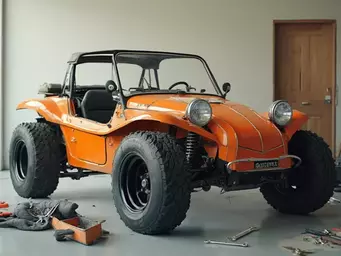 What if every turn of the wrench not only transformed your beach buggy but also deepened your passio
What if every turn of the wrench not only transformed your beach buggy but also deepened your passio
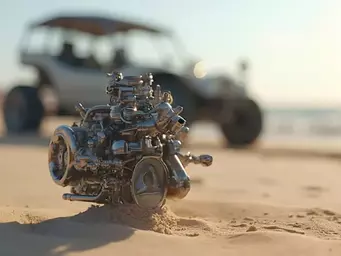 Upgrading your beach buggy isn't just about power—it's a journey towards better performance and en
Upgrading your beach buggy isn't just about power—it's a journey towards better performance and en
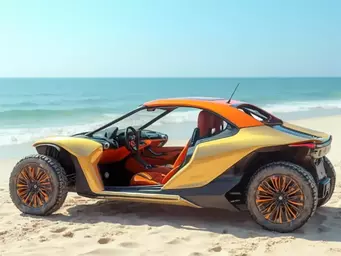 Have you ever felt the thrill of cruising along the shore in a custom beach buggy, the sun warming y
Have you ever felt the thrill of cruising along the shore in a custom beach buggy, the sun warming y
